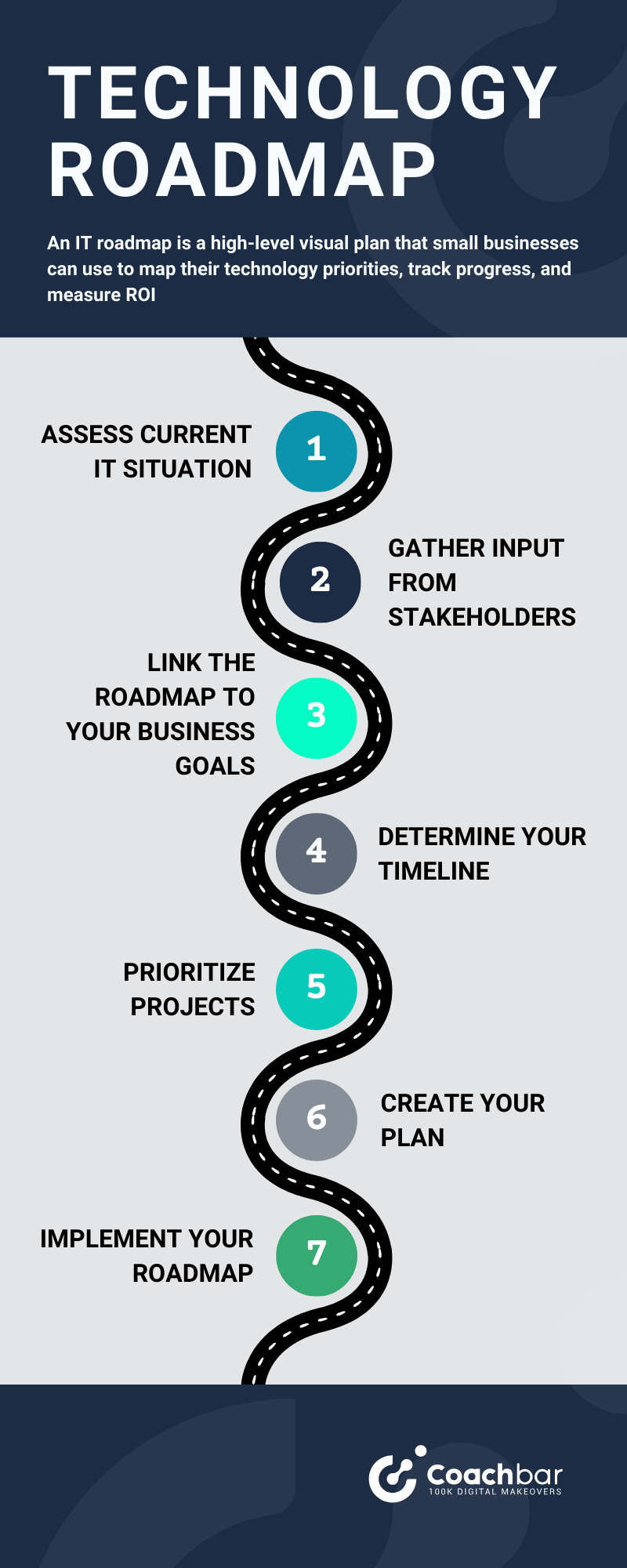A Technology Roadmap is a high-level visual plan that small businesses can use to map their technology priorities, track progress, and measure ROI. Still, almost 80% of small businesses aren’t taking advantage of widely available technology.
With a well-planned technology roadmap, businesses can plan out a long-term IT strategy, prepare for periods of growth, and reach the next level of success.
If you run a small business, this post will give you a step-by-step guide to creating an effective technology roadmap tailored to your growing brand.
Table of Contents
ToggleStep 1: Assess Your Current IT Situation
Before you can figure out where you want your business to be, you need to understand where you are. To do this, create a full inventory of each department’s software systems.
Make notes on what needs upgrading or replacing and what is working well. This first step is the time to be critical; record everything that’s not working optimally so you know exactly where the challenges lie. Later, you’ll be prioritizing this list, so make sure everything is included. Be sure to identify all users, both internal staff members and external customers, vendors, and advisors.
Step 2: Gather Input from Stakeholders
It’s tough to fully understand the limitations of current processes without talking to the staff members who use them each day.
During your research, conduct interviews with department heads and key stakeholders to get their honest feedback about your current systems.
You could also conduct a company-wide survey to get feedback from all staff members. Not only will this give you a better understanding of what works and what doesn’t, it will make your entire team feel more involved in the technology roadmap creation process.
Within the surveys, focus on technology wants, needs, and preferences. What software isn’t working? What could be improved? What systems would your team love to have?
The more detail you can collate at this point, the easier the next steps will be.
Step 3: Link the Roadmap to Your Business Goals
Now it’s time to think about your strategic priorities and link the roadmap to your business goals. These could include:
- Reducing effort and waste
- Boosting productivity and team efficiency
- Improving communication tools
- Adding value for clients
- Streamlining your services (69% of users agree ease of use is the most important factor when it comes to new technology.)
Note your company’s growth projections and think about how your roadmap will tie into these milestones. Any improvements you implement now need to be capable of handling future growth, so clearly defining your technology objectives and how they link into your roadmap is key.
Step 4: Determine Your Timeline
Now you know exactly what you want to change and how it ties into your company’s strategic goals, it’s time to put it all into an achievable timeline.
This should include two separate forecasts:
- A one-year timeline for immediate needs
- A three-to-five-year forecast for future planning
There will be tasks and projects on your list that need immediate attention, whether that’s issues with in-house communications, service delivery, or your supply chain. These should be added to the beginning of your roadmap to be improved or solved within the next year.
However, you might also have plans aimed at future growth. Although these aren’t pressing projects, adding them to your roadmap will keep them as a top priority and ensure you’re constantly working toward them.
Step 5: Prioritize Projects
Now everything is split into short-term and long-term plans, you’ll need to prioritize according to importance, urgency, and budget.
With the input of heads of departments and key stakeholders, figure out what projects are most urgent and need to be prioritized. These are the non-negotiable tasks that will make a significant difference to productivity, efficiency, and your bottom line.
Once you have all of your projects ranked, you can consider a budget for each project. Technology expenditure for SMBs is predicted to grow 7.4% year-over-year by 2025, showing just how committed small businesses are to digital transformations.
The less urgent the project is, the lower the budget or the further along your technology roadmap it sits.
Step 6: Create Your Plan
Finally, it’s time to put all of that important research into an actionable roadmap. There are plenty of online templates, and many project management tools (e.g., Asana, Monday, etc.) to help with the creation process.
But the easiest way to create an effective technology roadmap that gets real results is to consult a Coachbar business analyst. They can help you map out your goals, prioritize projects, and create a highly effective technology roadmap your team can truly benefit from. Coachbar business analysts can also connect you with expert software consultants who can help you move your roadmap from a plan into reality.
However you choose to create your roadmap, here’s everything it should include:
- Strategic business goals
- Improvements or upgrades you aim to make
- Project details, including who is involved and important milestones
- Costs for each project
- Timelines for each project
- Your plan for reviews/amendments
- How you will track progress and ROI of completed projects
Step 7: Implement Your Roadmap
No matter how detailed your technology roadmap is, it’s a useless document without proper implementation and maintenance.
Once you have the roadmap drafted, share it with department heads and key stakeholders to make sure you have their support.
Select key dates (either quarterly or annually) to conduct reviews and adapt your plan as needed. Even the most well-thought-out roadmap will hit speed bumps, so consistent reviews will help you keep on track.
The most essential part of the maintenance process is tracking progress and the ROI of completed projects. You need to be sure that your plans are having the desired effect and that you are consistently working toward your overall strategic business goals.
If you notice you’re not seeing the results or ROI you planned, figure out why and pivot to improve.
Need Help Creating Your Roadmap?
In an ever-changing technology landscape, a technology roadmap isn’t an option anymore; it’s an essential tool for business growth and continued success.
Whether you’re creating a technology roadmap for the first time or you’re struggling to get the results you want with the one you currently have, we can help.
At Coachbar, our business analysts can help you create an effective roadmap to keep your business on the path to success.
Get in touch today to arrange a consultation and we'll walk you through the process.





